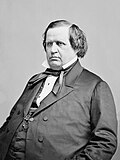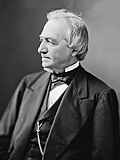Top Qs
Timeline
Chat
Perspective
List of United States Supreme Court cases, volume 100
From Wikipedia, the free encyclopedia
Remove ads
This is a list of cases reported in volume 100 of United States Reports, decided by the Supreme Court of the United States in 1879 and 1880.[1]
Remove ads
Justices of the Supreme Court at the time of 100 U.S.
Summarize
Perspective
The Supreme Court is established by Article III, Section 1 of the Constitution of the United States, which says: "The judicial Power of the United States, shall be vested in one supreme Court . . .". The size of the Court is not specified; the Constitution leaves it to Congress to set the number of justices. Under the Judiciary Act of 1789 Congress originally fixed the number of justices at six (one chief justice and five associate justices).[2] Since 1789 Congress has varied the size of the Court from six to seven, nine, ten, and back to nine justices (always including one chief justice).
When the cases in 100 U.S. were decided the Court comprised the following nine members:
Remove ads
Notable Cases in 100 U.S.

Trade-Mark Cases
The Trade-Mark Cases, 100 U.S. 82 (1879), were three cases consolidated into a single appeal before the United States Supreme Court, which in 1879 ruled that the Copyright Clause of the Constitution gives Congress no power to protect or regulate trademarks. In response, Congress passed the Trade Mark Act of 1881, which was based on its Commerce Clause power and therefore passed constitutional review.
Strauder v. West Virginia
Strauder v. West Virginia, 100 U.S. 303 (1880), was the first instance in which the Supreme Court reversed a state court decision denying a defendant's motion to remove his criminal trial to federal court under Section 3 of the Civil Rights Act of 1866.[3] The Court's holding established the proposition that it is a denial to criminal defendants of the equal protection of the law for a state to exclude persons from service on a grand or petit jury on account of race, color, or previous condition of servitude.
Remove ads
Citation style
Summarize
Perspective
Under the Judiciary Act of 1789 the federal court structure at the time comprised District Courts, which had general trial jurisdiction; Circuit Courts, which had mixed trial and appellate (from the US District Courts) jurisdiction; and the United States Supreme Court, which had appellate jurisdiction over the federal District and Circuit courts—and for certain issues over state courts. The Supreme Court also had limited original jurisdiction (i.e., in which cases could be filed directly with the Supreme Court without first having been heard by a lower federal or state court). There were one or more federal District Courts and/or Circuit Courts in each state, territory, or other geographical region.
Bluebook citation style is used for case names, citations, and jurisdictions.
- "C.C.D." = United States Circuit Court for the District of . . .
- e.g.,"C.C.D.N.J." = United States Circuit Court for the District of New Jersey
- "D." = United States District Court for the District of . . .
- e.g.,"D. Mass." = United States District Court for the District of Massachusetts
- "E." = Eastern; "M." = Middle; "N." = Northern; "S." = Southern; "W." = Western
- e.g.,"C.C.S.D.N.Y." = United States Circuit Court for the Southern District of New York
- e.g.,"M.D. Ala." = United States District Court for the Middle District of Alabama
- "Ct. Cl." = United States Court of Claims
- The abbreviation of a state's name alone indicates the highest appellate court in that state's judiciary at the time.
- e.g.,"Pa." = Supreme Court of Pennsylvania
- e.g.,"Me." = Supreme Judicial Court of Maine
List of cases in 100 U.S.
Remove ads
Notes and references
External links
Wikiwand - on
Seamless Wikipedia browsing. On steroids.
Remove ads











